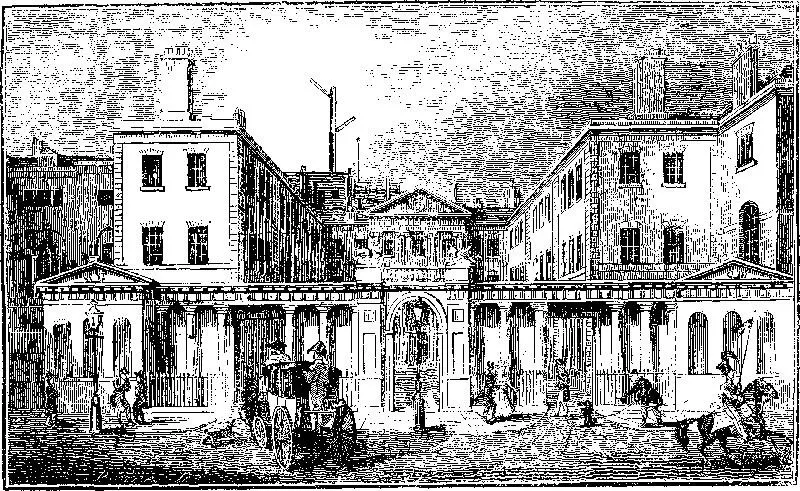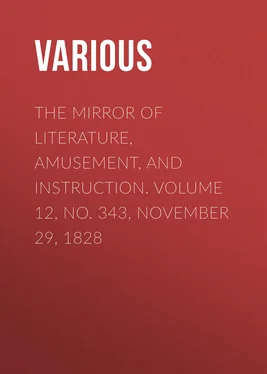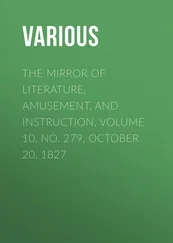Various - The Mirror of Literature, Amusement, and Instruction. Volume 12, No. 343, November 29, 1828
Здесь есть возможность читать онлайн «Various - The Mirror of Literature, Amusement, and Instruction. Volume 12, No. 343, November 29, 1828» — ознакомительный отрывок электронной книги совершенно бесплатно, а после прочтения отрывка купить полную версию. В некоторых случаях можно слушать аудио, скачать через торрент в формате fb2 и присутствует краткое содержание. Жанр: foreign_antique, periodic, Развлечения, foreign_edu, на английском языке. Описание произведения, (предисловие) а так же отзывы посетителей доступны на портале библиотеки ЛибКат.
- Название:The Mirror of Literature, Amusement, and Instruction. Volume 12, No. 343, November 29, 1828
- Автор:
- Жанр:
- Год:неизвестен
- ISBN:нет данных
- Рейтинг книги:5 / 5. Голосов: 1
-
Избранное:Добавить в избранное
- Отзывы:
-
Ваша оценка:
- 100
- 1
- 2
- 3
- 4
- 5
The Mirror of Literature, Amusement, and Instruction. Volume 12, No. 343, November 29, 1828: краткое содержание, описание и аннотация
Предлагаем к чтению аннотацию, описание, краткое содержание или предисловие (зависит от того, что написал сам автор книги «The Mirror of Literature, Amusement, and Instruction. Volume 12, No. 343, November 29, 1828»). Если вы не нашли необходимую информацию о книге — напишите в комментариях, мы постараемся отыскать её.
The Mirror of Literature, Amusement, and Instruction. Volume 12, No. 343, November 29, 1828 — читать онлайн ознакомительный отрывок
Ниже представлен текст книги, разбитый по страницам. Система сохранения места последней прочитанной страницы, позволяет с удобством читать онлайн бесплатно книгу «The Mirror of Literature, Amusement, and Instruction. Volume 12, No. 343, November 29, 1828», без необходимости каждый раз заново искать на чём Вы остановились. Поставьте закладку, и сможете в любой момент перейти на страницу, на которой закончили чтение.
Интервал:
Закладка:
Various
The Mirror of Literature, Amusement, and Instruction / Volume 12, No. 343, November 29, 1828
THE ADMIRALTY-OFFICE

The Admiralty Office, Whitehall , has few pretensions to architectual beauty. It is, however, to use a common phrase, a commanding pile, and its association with Britain's best bulwarks—her NAVY—renders it an interesting subject for representation.
The Admiralty-office adjoins to the north side of the Horse Guards, and was erected by Ripley, in the reign of George II., on the site of Wallingford House. It recedes from, but communicates with, the street by advancing wings, and is built principally of brick. In the centre of the main building is a lofty portico, of the Ionic order, the taste of which is not entitled to much praise. It consists of four columns, and on the entablature is an anchor in bold relief. Here are the offices, and the spacious abodes of the lords commissioners of the admiralty, together with a handsome hall, &c. On the roof of the building is a Semaphore telegraph, which communicates orders by signal to the principal ports of the empire.
But the most tasteful portion of the whole, is a stone screen, by Adams, in front of an open court, and facing the street. The style is exceedingly chaste and pleasing, and the decorations are characteristic naval emblems, finely executed. The representation of two ancient vessels in the end entablatures, merit especial notice.
Since the appointment of the Duke of Clarence to the office of lord high admiral, the Admiralty has been the town residence of his royal highness. The exterior has been repaired, and the interior in part refitted. The screen has likewise been renovated with much care, and two of the entrances considerably enlarged, but with more regard to convenience than good taste. The portion occupied by the royal duke contains a splendid suite of state rooms, within whose walls have frequently been assembled all the bravery, as well as rank, of the empire; for the interests of the noble service are too dear to his royal highness to be eclipsed by the false lights of wealth or fashion.
HUITAIN DE CLEMENT MAROT
Plus ne suis ce que j'ay esté
Et ne le scaurois jamais estre,
Mon beau printemps et mon esté
Ont fait le saut par la fenestre.
Amour! tu as esté mon maistre
Je t'ai servi sur tous les Dieux,
O si je pouvois deux fois naistre,
Comment je te se virois mieux!
I am no more, what I have been
And ne'er again shall be so.
My summer bright, my spring time green,
Have flown out of the window.
Oh love, my master thou hast been,
I, first of gods, instal thee,
Oh! could I e'en be born again,
Thou doubly would'st enthral me.
TEMPLE AT ABURY
There is an inconsistency in the account of Abury in No. 341, perhaps overlooked by yourself.
I would ask, how could that arrangement of the fabric, so fancifully and ingeniously described by Stukely, be intended to represent the Trinity, when the place was confessedly in existence long anterior to Christianity? nor is there any thing in the old Druidical or Bardic tenets that can be twisted to any such idea.
This Abury , with Silbury , is supposed to be the Cludair Cyfrangon , or Heaped Mound of Congregations , mentioned in the Triads , the building of which is recorded as "one of the three mighty achievements of the Isle of Britain;" and here were held the general assemblies of the Britons on religious occasions, and not at Stonehenge, as is generally supposed. This last place is decidedly more modern than the pile at Abury ; the Welsh call it Gwaith Emrys, (the work of Emrys ,) and it ranks as another of the mighty achievements of the Isle of Britain, the third being "the raising of the Stone of Keti," supposed to be the " Maen Ceti " at Gwyr, in Glamorganshire.
The presumption that Stonehenge is more modern than Abury is founded upon the fact that Stonehenge exhibits marks of the chisel in different parts, while the former does not. The ancient British documents give us the founder of the latter, namely, Emrys , or Ambrosius , while we are left in ignorance as to who raised the pile of Cyfrangon .
Nor was Stonehenge ever of such magnitude as Abury , the diameter of the former being 99 feet, whilst the latter was 1,400; the largest stones of the former weigh 30 tons, but the latter weigh 100 tons!
Gwaith Emrys was possibly more for political than religious assemblies. Here was held the meeting of the Britons and Saxons, when the Plot of the Long Knives ( Twyll y Cyllyll Hirion ) was consummated, and the flower of the British chiefs treacherously destroyed by their pretended friends.
Different authors have strenuously contended for giving the honour of supremacy to either of these places over both Britain and Gaul, in the days of Druidism; but Rowlands has industriously placed its chief seat in Anglesey.
LEATHART.TRANSLATED EPITAPH
Quod fuit esse quod est, quod non fuit esse quod esse,
Esse quod est non esse, quod est non, erit esse.
As a translation of this curious epitaph (in Lavenham churchyard) which is formed out of two Latin words, has been requested from some of your readers, I send the following:—
What John Giles has been
Is what he is, ( a bachelor .)
What he has not been,
Is what he is, ( a corpse .)
To be what he is
Is not to be, ( a living creature .)
He will have to be
What he is not. ( dust .)
What we have been and what we are,
The present and the time that's past,
We cannot properly compare
With what we are to be at last.
Tho' we ourselves have fancied forms,
And beings that have never been,
We unto something shall be turned—
Which we have not conceived or seen.
MARY QUEEN OF SCOTS
The ensuing letter, though very short, discloses one or two instances connected with a subject of unfading interest—the death of Mary Queen of Scots. It need hardly be stated, says an able writer on this subject, that Queen Elizabeth's conduct with respect to the execution of Mary was a mixture of unrelenting cruelty, despicable cowardice, and flagitious hypocrisy; that whilst it was the dearest wish of her heart to deprive her kinswoman of her existence, she attempted to remove the odium of the act from herself, by endeavouring to induce those to whose custody she was intrusted to assassinate their prisoner; that when she found she could not succeed, she commanded the warrant to be forwarded; and that when she knew it was too late to recall it, asserted that she never intended it should be carried into execution, threw herself into a paroxysm of affected rage and grief, upbraided her counsellors, and first imprisoned and then sacrificed the fortunes of her poor secretary, Davison, one of her most virtuous servants, as a victim to her own fame, and the resentment of the King of Scots. These damning facts in the character of Elizabeth are too well known to require to be dilated on; they have eclipsed the few noble actions of her life, and remain indelible spots on her reputation as a woman and a sovereign. But we learn from this letter the humiliating effects made by her ministers to appease her fury, and her implacable resolution to overwhelm the unfortunate Davison with the effect of her assumed, or perhaps real repentance. In his apology, that statesman informs us, that on the Friday after Mary's execution, namely, on the 10th of February, arriving at the court he learnt the manner in which the queen had expressed herself relative to the event; but being advised to "
Читать дальшеИнтервал:
Закладка:
Похожие книги на «The Mirror of Literature, Amusement, and Instruction. Volume 12, No. 343, November 29, 1828»
Представляем Вашему вниманию похожие книги на «The Mirror of Literature, Amusement, and Instruction. Volume 12, No. 343, November 29, 1828» списком для выбора. Мы отобрали схожую по названию и смыслу литературу в надежде предоставить читателям больше вариантов отыскать новые, интересные, ещё непрочитанные произведения.
Обсуждение, отзывы о книге «The Mirror of Literature, Amusement, and Instruction. Volume 12, No. 343, November 29, 1828» и просто собственные мнения читателей. Оставьте ваши комментарии, напишите, что Вы думаете о произведении, его смысле или главных героях. Укажите что конкретно понравилось, а что нет, и почему Вы так считаете.












